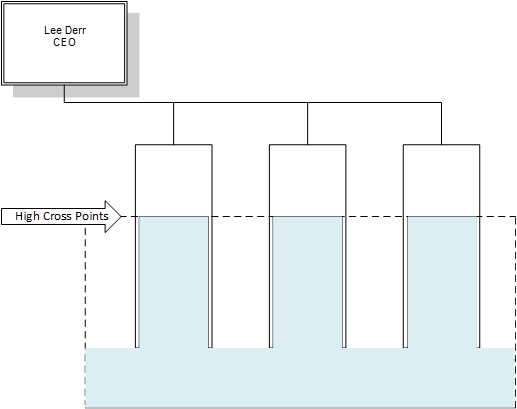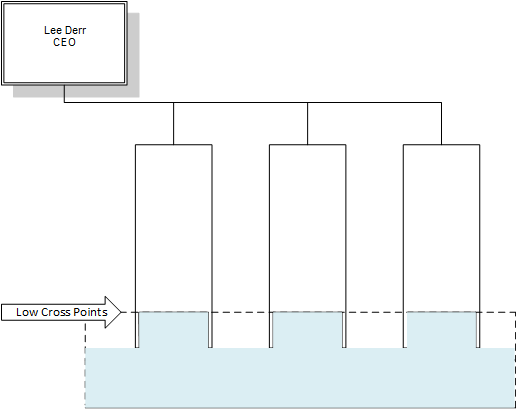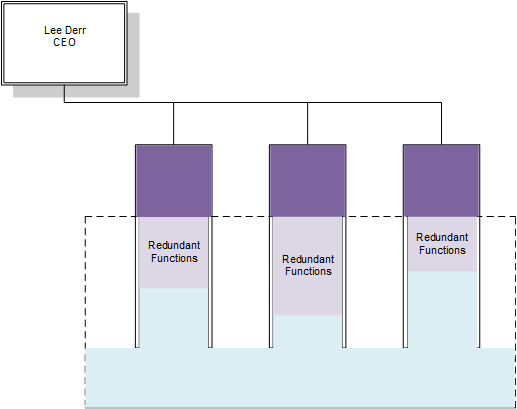Blog Barista: Bob Marquis, CPA, PMP | Dec 12, 2018 | Project Management | Brew time: 8 min
In Part One of this post, I said that despite the complexity of a matrixed structure, there are many good reasons to use one, particularly for a horizontal PMO in a large organization. In part two, we’ll look at some of the advantages and disadvantages of the matrixed structure, as well as key factors necessary for an organization to be successful using a horizontal PMO.
Advantages and Disadvantages
As you might expect, there is not a “perfect” organizational structure. What might be right for one organization may not be best for another. There are pros and cons to both the traditional hierarchical structure and the matrixed structure. These pros and cons affect individuals as well as the organization itself. So, first let’s look at how the structures may affect individuals.
Impact on the Individuals
Staff generally find it easier to understand organizations that are primarily hierarchical. In the pyramid-shaped hierarchical structure, everyone reports only to the one above them. There are levels within the organization. Everyone knows where they fit in the pecking order, and they know where everyone else fits too.
Traditional structures encourage a sense of accountability to the direct manager. This manager directs employees work, knows their performance, and within organizational bounds, handles or at least influences employee compensation. Communication is direct. Employees easily understand their role and the expectations of them.
On the down-side, employees who are not pursuing a general management career path may find limited career growth. If an employee is specialized and not moving up the main business management chain, there is only limited opportunity to grow in their area of capability or interest. Advancement for them is often a result of waiting for attrition. For example, it is difficult for a Project Coordinator or Scheduler to become a Project Manager unless the project manager above them leaves. Good employees often find they need to go to a different organization for career advancement.
In a matrixed structure, horizontal staff report to the leader of their capability group not a vertical manager. In our project management example, all project management staff report to the PMO leader. In a large organization, there are multiple Project Managers, Coordinators, and Schedulers in the PMO. Employees can more easily advance on their merits.
One of the most significant struggles for managers and employees in a matrixed organization is communication. Employees can feel like they are pulled in two directions if their direct manager and their dotted-line vertical manager are not on the same page. An employee may get mixed messages and be torn when trying to follow the direction of each. When trying to resolve this, an employee may lean toward their direct manager since that person ultimately controls their compensation. On the other hand, since their direct manager does not see their day-to-day work, an employee may lean toward their dotted-line manager in order to get a good performance review. Employees can end up walking a tight-rope or worse, doing nothing until they get clarification. They feel like they are in a no-win situation.
Impact on the Organization
In a hierarchical organization, there can be significant variability in service, processes, and expertise across the organization. It is difficult for a vertically siloed organization to drive standards and best practices when each functional area controls their own resources.
This is the primary advantage of the matrixed structure. With a horizontal delivery group, there is more consistency and efficiency in the delivery of services across the organization. The organization has much more confidence that services delivered from all verticals will be consistent and will follow established standards.
Delivery costs are usually lower as well. Typically, resources are more appropriately allocated based on their skills. This results in cost efficiencies, as higher skilled (and paid) staff are allocated to work which requires their skills and not to lower skilled activities. In the vertical structure, resources tend to do whatever is needed because often there isn’t anyone else to do it. This is admirable, but unfortunately inefficient. It’s like a hospital having a doctor checking in patients and doing blood draws instead of having a receptionist and a blood tech. Admirable, but expensive. In our PMO example, a vertical can’t justify hiring 3 people, so they must either have someone with the highest-level skill do all of the work, or they hire someone less skilled and suffer quality issues at the high end.
The matrixed structure consolidates specialized resources and allows the organization to most efficiently allocate them.
How to be a Successful Matrixed PMO
One of the most important considerations in a matrixed organization is determining at what level to matrix the verticals and the horizontals. What resources should remain in the vertical groups and which should be in the horizontal groups? In other words, at what level do the groups “cross?”
We can think of the horizontals as either deeply embedded into the vertical or only slightly embedded. When horizontals are deeply embedded, there are very few vertical resources. Often, even vertical-specific expertise (i.e., industry, client, program, etc.) resides in the horizontal group. The horizontal carries more resources to support the vertical.
On the other hand, if the horizontal is only slightly embedded, the vertical-specific expertise, and usually some horizontal expertise, is in the vertical. In this case, the horizontal group delivers only the most basic of services.
High Cross Points

The cross-points or matrix points in this arrangement are “high” in that the horizontal group crosses the vertical group father up in the vertical.
However, if the cross points are too high, meaning too many vertical-specific resources are transferred into horizontal groups, the organization can lose vertical-specific expertise. This often means less satisfaction from vertical leaders and their clients who want someone that really knows their business. As we’ll see further below, this can also lead to redundancy of resources as the vertical leaders try to mitigate the situation by hiring their own expertise.
This situation of cross points that are too high often arises when an organization gets carried away with efficiency and loses sight of client satisfaction. If this occurs, the organization may need to unwind some of the consolidation of resources. While some of the value of horizontal resources may be lost, there are strategies that can be employed to maintain value. For instance, horizontal Communities of Practice can be established that allow similar resources in all of the verticals to keep knowledge sharing active among them. Likewise, cross-vertical audits can be instituted to ensure the use of established project management standards across all verticals.
Low Cross Points

In the opposite situation, if the cross points are too low, meaning there are minimal or weak horizontal groups, the organization loses the matrix benefits. Essentially, the organization is not really matrixed. Cost efficiencies, common processes, resource specialization, career paths, etc. suffer.
This situation often arises when horizontal groups are not perceived as adding value, they do not have sufficient organizational support, or they have been weakened over time. Mitigating this may require developing some vertical-specific knowledge within the horizontal group, measuring value, and having senior leadership articulate their commitment to the matrixed structure.
In our PMO example, the question of what level to cross project management resources often manifests itself specifically with Project Managers. In other words, should higher-skilled Project Managers be vertical resources or horizontal resources? In I.T. in particular, is it more important that PMs are highly-skilled in I.T. (horizontal) or that they truly understand the business (vertical)? Strategically, there must also be agreement between the business units and the PMO on the responsibilities of the PMs. Are PMs supposed to “run the show” or simply be the umpire and “call it as they see it?” Do they have authority and responsibility to direct business resources and drive results or are they only monitoring, facilitating, and reporting on the project?
Vigilance is Required
To have an effective and efficient matrixed structure, leaders must stay aware of two natural tendencies in matrixed organizations. One tendency is toward a redundancy of functions within the vertical and the horizontal. (And this gets even more complicated when there is inconsistency in the amount of redundancy across different verticals.) A second natural tendency is the tendency of vertical leaders to want their own direct resources. These two tendencies can play together to result in excess staff, role confusion about “who is doing what,” and inefficient resource utilization.

An important strategy to mitigate these natural tendencies, and to bolster employee satisfaction, is to have roles and responsibilities well defined. This doesn’t mean stifling the organization with bureaucratic micro job descriptions. It means ensuring that leaders are in agreement about what the horizontal resources will do and what functions the verticals retain. It means that communication is clear and that there is a well-understood process to address any confusion.
As mentioned at the beginning, there is not “one right answer.” There are a number of factors that go into determining the optimal cross points for any given organization. These include the degree of specialization of each vertical, skills of employees, staff turnover, etc. Organizations should analyze and evaluate their own specific needs and priorities to determine what is right for them.
Other recent posts:

Kunz, Leigh and Associates (KL&A) Announces the Retirement of KL&A Co-Founder John Leigh
OKEMOS, MI, April 11, 2023 – Kunz, Leigh and Associates (KL&A) announces the recent retirement of KL&A Co-Founder John Leigh as of March 31, 2023. Mr. Leigh began his career as a developer working on large mainframe systems before moving…

Team Building in a Remote Environment
Blog Barista: Dana Graham | June 15th, 2022 | Culture | Brew time: 5 min
Let me start by saying I don’t care for the term “work family.” I have a family I love, and they have absolutely nothing to do with my career. I want my work life to be its own entity. I like boundaries (and the George Costanza Worlds Theory). Certainly, I want to enjoy and trust my coworkers, and I want to feel supported and cared for…
0 Comments